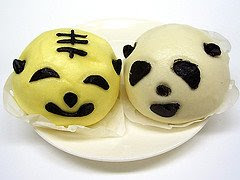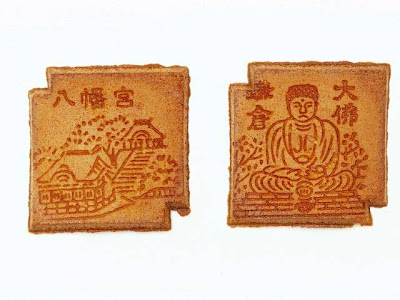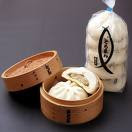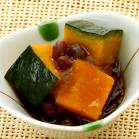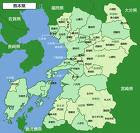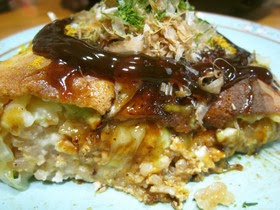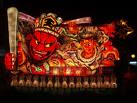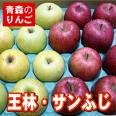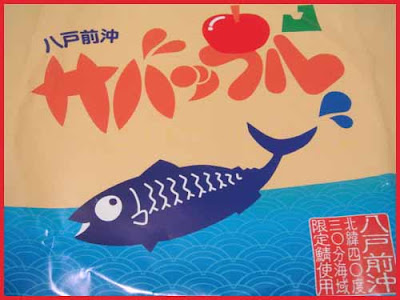::::::::::::::::::::::::::::::::::::::::::::::::::::::::::::::::::::::::::::::::::::::::::::::::::::
Vegetable stew (noppejiru)
***** Location: Niigata, Japan
***** Season: Topic
***** Category: Humanity
*****************************
Explanation
Vegetable broth with mixed ingredients, noppejiru
のっぺ汁
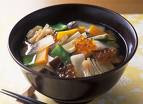
noppei のっぺい)「能平」 「濃餅」
The NOPPE of Niigata is not a soup, but a kind of stew or hodgepodge.
It is prepared from vegetables and dashi broth. Sometimes Kamaboko or salted salmon is added.
Often eaten on festival days, for the New Year and on funeral memorial days.
Noppejiru, the soup version, is served in many areas of Japan and prepared in this way:
Left-over stems and skins of vegetables used for other food are stir-fried in sesame oil and then made into a soup.
Other ingredients are then added according to the area, for example taro or yam, carrots, burdock, shiitake mushrooms and abura-age deep-fried bean curd. Soy sauce and salt are then added and some katakuriko starch to thicken the broth.
Sometimes chicken or fish pieces are added.
The origin is from temple food, when the cook-monks of the Obaku Zen-sect boiled vegetables and added kuzu starch for thickening, to prepare it in the way of Chinese fucha cooking
oobaku 黄檗宗
Fucha ryori, fucha ryoori, Chinese monk quisine
普茶料理
a kind of shoojn ryori, shoojin ryoori, monk quisine 精進料理.
see below.
:::::::::::::::::::::::::::::::::::::::::::::::::::::::::::::::::::::::::::::::::::::::::::::::::::
なお、長野県の佐久地方で明治まで割元の職を務めながら中山道を往来した大名に食事や宿を提供していた篠澤佐五右衛門家には、慶安元年(1648年)の献上料理の献立表が現存している。この文献によると小諸城主青山因幡守に篠澤佐五右衛門良重が料理を提供し、その中に「のっぺい汁」があった。記述によると、その汁は鍋仕立であり鴨肉が使われ、わさびが添えられていた。篠澤佐五右衛門家は当時から岩村田の今宿で連綿と宿を営み、今もこののっぺい汁を再現調理して提供をしている。またこの献立の文献は現在、佐久市立望月民族資料館にて公開されている。
© More in the WIKIPEDIA !
:::::::::::::::::::::::::::::::::::::::::::::::::::::::::::::::::::::::::::::::::::::::::::::::::::::
Another famous soup from Niigata is
banyajiru 番屋汁(ばんやじる) "soup of the guardian house"
It used to be cooked right at the harbor or beach at the guardian house (banya) of the area. Fish innards cut in small pieces, shells and mussles of the day's catch, some caggabe,leek and other available vegetables where dumped in hot water and salt or miso paste used as flavoring. It was brewed to warm the fisherman after coming back to land.
Wachthaus-Suppe
:::::::::::::::::::::::::::::::::::::::::::::::::::::::::::::::::::::::::::::::::::::::::::::::::::::
Another speciality from Niigata
Sasadango 笹団子 (ささだんご)
Rice dumplings wrapped in sasa bamboo grass leaves
Originally a portable food during the Warring States period. Sasadango are made of mugwort-flavored glutionus rice (mochigome) and red beans, the paste is than wrapped in sasa leaves.
In former times, local families made them also during the holiday periods.
*****************************
Worldwide use
*****************************
Things found on the way
Manpukuji, where Chinese cuisine took root in Japan
Temple played key role in spread of new ingredients, cooking techniques
UJI, Kyoto (Japan)
The deep-rooted influence of Chinese culture is easily spotted in contemporary Japan, but perhaps most obviously in the nation's food culture. Manpukuji temple, founded here by a Chinese monk in the 17th century, played an essential role in the spread of Chinese cuisine across the nation.
Zen-style calligraphy and portraiture techniques introduced from China by the temple's monks and devotees were highly regarded by Japan's cultural elite at the time, but none equalled the impact of
fucha ryori 普茶料理, the Chinese-style Buddhist vegetarian cuisine. Indeed, its impact is still keenly felt today.
"The cuisine has had an unequalled effect on the development of Kansai's food culture," says Chisei Tanaka, a priest and chief researcher at the temple's Obaku Cultural Research Institute. "It brought new ingredients and combined boiling, grilling and steaming procedures."
"[After the founding of Manpukuji temple] the nation experienced a major boom in fucha ryori--much more exuberant than what you see for French or Italian food now," Tanaka says.
Fucha ryori cuisine was also credited with popularizing techniques in deep-frying and stir-frying, which used large amounts of oil, then a luxury item. Its innovative style of dining using tables and Chinese tableware with an elaborate presentation was popular among the general public and feudal lords alike.
Manpukuji temple was established in 1661 by the Chinese monk Yinyuan Longqi (1592-1673), known as Ingen Ryuki in Japanese. He would later be recognized as the founder of Obaku, the last of the three Japanese Zen sects to be founded (the others are the Rinzai and Soto sects), and the first to be based on the teachings of a Chinese monk.
Ingen was well known in Japan before his arrival in the nation in 1654 at the age of 63, thanks to his many Zen-related writings, says Korei Okada, the current head priest of Manpukuji temple, which is still the Obaku sect's headquarters.
"Many Japanese monks rushed to see him after his arrival in Nagasaki [the only gateway from China at the time]," Okada says. "China was regarded as a cultured nation in what was a period of isolation for Japan, and his arrival caused an Obaku boom."
Ingen was accompanied to Nagasaki by Chinese disciples and artisans, including architects, sculptors, tailors and tofu makers. He also brought several foods that had never before been seen in Japan, such as kidney beans, watermelons and renkon (lotus root). The beans, used widely today, are called ingenmame in his honor.
His sermons at Nagasaki temples attracted crowds of monks as well as lay people and were received as a breath of fresh air by those disillusioned with the state of Buddhism in the nation. According to Okada, Japanese Buddhism circles were in disarray following a period of war, with gambling and other inappropriate behavior often being spotted at temples.
"Ingen, who strictly observed commandments prohibiting marriage and eating meat, was considered an ideal priest for Japanese monks to learn from, and many people visited him in Nagasaki, either to become his disciples or to meditate with him," Okada says.
Ingen was scheduled to return to China after three years, but extravagant efforts by his followers persuaded him to stay in Japan. He was introduced to the 4th shogun, Tokugawa Ietsuna (1641-1680), in 1658 and given land in Uji to build a Zen temple.
Ingen named the temple Manpukuji, which is written using the Chinese characters for "man" and "fuku," respectively meaning "ten thousand" and "fortune," just like Wanfu Temple in Fujian Province, where he had served as head priest before he left for Japan.
The foundation of the temple boosted Ingen's influence significantly, and many highly educated Chinese monks followed him to Japan to serve at Manpukuji temple and elsewhere. The Obaku sect was widely embraced, and at its peak had about 1,000 temples, creating a powerful base for promoting aspects of Chinese culture.
Most acclaimed of these was the original taste and exotic presentation of fucha ryori. In the Edo period (1603-1867), its popularity spread quickly, boosted by the publication of many cookbooks about the cuisine, and was entrenched by the opening of fucha ryori restaurants in Nagasaki, Osaka, Kyoto and Edo, present-day Tokyo.
"I believe people who were served fucha ryori at special events at that time must have sung its praises far and wide for its reputation to have been so widespread," Okada says.
Visitors to Manpukuji today also enjoy many other elements of Chinese culture the temple community helped to popularize and an atmosphere that has remained unchanged for about 350 years.
The close attention Ingen paid to reproducing the atmosphere of Chinese temples when overseeing the construction of Manpukuji is striking. The temple's three main halls stand lengthwise, perfectly aligned, with other buildings opposite them creating a powerful sense of symmetry, a layout typical of Chinese Zen Buddhist temples built during the Ming dynasty (1368-1644).
Most of the main buildings are remarkably well-preserved, having maintained their original structure since their construction in the 1660s.
Entering the temple through Sanmon gate--which still boasts original nameplates of the temple and the mountain, inscribed by Ingen himself--visitors walk a path of diamond-shaped stones toward the main attractions.
Dozens of Buddhist statues showcase the excellent craftsmanship of the Ming dynasty, the most famous of which is the wooden statue of Hotei, god of fortune, at Tennoden hall. About 110 centimeters tall and covered in gold leaf, it is a popular symbol of the temple and often appears on the cover of sightseeing magazines.
A 230-centimeter-long, fish-shaped gong hanging from the ceiling of Saido dining hall is struck by a monk with a wooden pole to announce daily events and rituals.
The Daiohoden hall, the nation's largest teak building, houses 18 unique statues of arhats (Buddhists who have attained enlightenment) and a seated statute of Shakanyorai, Manpukuji temple's principal image. At special exhibitions, visitors can view fascinating Chinese calligraphy scrolls and portraits of monks drawn in the realist Obaku style, with sharp lines and contrasting colors.
In the Hozoin temple, a collection of 60,000 printing blocks inscribed with more than 6,900 volumes of sutras is piled high on shelves. The blocks were made in a major project launched by Tetsugen Doko (1630-1682), one of Ingen's Japanese disciples, and feature the Ming typeface that even today remains the nation's most common typeface, seen everywhere in newspapers and books. The sutras are individually printed even now.
The temple's fascinating tours attract plenty of visitors, and many seize the opportunity to enjoy the experience of beautifully arranged, delicious and nutritious fucha ryori.
Fucha ryori was originally served to all the monks who gathered at meetings after major Buddhist rituals or services were completed.
During the rituals or services, five-colored vegetables, most often carrot, cucumber and Japanese radish, as well as deep-fried tofu, dried kelp, and manju sweet bean paste buns are offered to Buddhist altars or mortuary tablets. The foods bound with palm leaves and stood upright on stands are cooked and served to monks after the events end.
(junkan 笋羹(じゅんかん) , shankon 上旬.)
Multiple dishes--a typical fucha ryori meal nowadays includes six or seven--are arranged on large communal plates for four diners, who serve themselves with their own chopsticks.
That no scrap of food is wasted is a fundamental teaching clearly reflected in fucha ryori. Scraps of vegetables can be sauteed to make unpen, which has a thick sauce. Dried-out manju are deep-fried and served as tomoe manju.
Gisho Ienaga, the tenzo monk who supervises culinary operations at the temple, says: "We try to meet diners' expectations of Kyoto cuisine. We serve a variety of dishes that are meticulously prepared and decorated with color and sophistication."
Among the dishes are shunkan 笋羹(じゅんかん junkan) --assorted simmered dishes, including vegetables rolled in a sheet of deep-fried tofu and hiryuzu, deep-fried tofu balls with chunky vegetables--
and yuji 油磁(ゆじ), tempura vegetables with tomoe manju.
Seafood and meat products are of course prohibited, but some dishes are prepared to represent them symbolically. For example, tofu with grated burdock and yam can be shaped and colored with seaweed so it resembles broiled eel.
Kanken Kiyozumi, a priest who assists Ienaga, explains the delicate nature of the fucha ryori cooking process through the example of a sesame tofu dish made with nutritious kudzu starch.
"It's really difficult to make, because kudzu hardens easily and burns. I have to stir the mixture of sesame paste and kudzu constantly in a pot for about 20 minutes, until it hardens.
"The taste of the dish differs completely from day to day," Kiyozumi says. "Even when I think I've made it perfectly, I can feel the consistency is different when I cut it, so I've never been satisfied with the tofu I've made."
source : www.buddhistchannel.tv
mafu 「麻腐(まふ), gomadoofu sesame tofu with sanshoo pepper
unpen 雲片(うんぺん) left over vegetables fried
kanpai 羹杯(かんぱい) hitashi type food
en , tsuai えん(菜)つぁい tsukemono pickles
hantsuu 飯子(はんつう) cooked rice
Vegetarian Temple Food (shoojin ryoori 精進料理)
.................................................................................
When leaving temple Manpukuji, the poetress Kikusha writes, summing up the Chinese atmosphere and the tea plantations:
山門を出れば日本ぞ茶摘うた
sanmon o dereba Nihon zo chatsumi uta
outside the temple gate
it's Japan again!
song of the tea pickers
. Tagami Kikusha 田上菊舎
(1753, August 23 -1826, September 24)
- - - - -
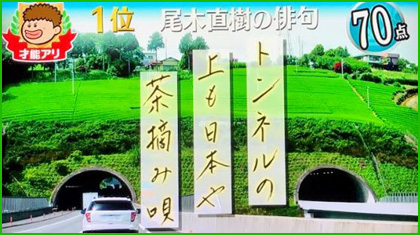
トンネルの 上も日本や 茶摘み唄
tonneru no ue mo hihon ya chatsumi uta
above the tunnel
there is also Japan !
song of the tea pickers
尾木直樹 Ogi Naoki, 尾木ママ Ogi "Mama"
During a Haiku battle program with Natsuki Sensei - April 2017
プレバト才能ランキング
:::::::::::::::::::::::::::::::::::::::::::::::::::::::::::::::::::::::::::::::::::::::::::::::::::::
Another temple with the name Manpukuji 満福寺 in Fukushima, Tohoku
御佛に尻むけ居れば月涼し
mihotoke ni shirimuke oreba tsuki suzushi
I turn my back
on the Buddha statue -
the moon is cool
. Masaoka Shiki 正岡子規 .
Shiki wrote an essay "hateshirazu no ki はて知らずの記" (kind of "never-ending story")
on his trip to Tohoku region (North-East Japan) during the 26th year of Meiji (1893). There is description that he stayed at a temple named Iidesan Manpukuji (飯出山満輻寺 / 満福寺). This haiku was written there.
He must have laid himself in the garden with the Buddha statue behind and looking at the moon....
- Thanks to Hideo Suzuki ! FB
正岡子規の句碑 - 竜護山萬福寺 Manpuku-Ji, Fukushima
Temple famous for its cherry blossoms
source : www.t-aterui.jp/fukushima
MORE haiku by Masaoka Shiki about
. Dead Body (hotoke) and mihotoke 御佛 .
:::::::::::::::::::::::::::::::::::::::::::::::::::::::::::::::::::::::::::::::::::::::::::::::::::::
observance kigo for the New Year
Oobaku Hoozan 黄檗放参
Evening Zen at Oobaku Zen Temples
Other events in Januaray
New Years Ceremony 修正会 (Shushoe)
(January 1–3)
New Years Completion Ceremony 修正滿散会 (Shusho Mansan-e)
(January 3)
Rinzai Day Observance 臨濟忌 (Rinzai-ki)
(January 10)
Hyakujo Day Observance 百丈忌 (Hyakujo-ki)
(January 17)
Ceremonies Marking Special Months of Cultivation
善月祈禱会 (Zengetsu Kito-e)
(January 16, May 16, and September 16)
source : Rinzai - Annual Events
SAIJIKI – NEW YEAR OBSERVANCES
*****************************
HAIKU
のっぺ汁冷めても酒の肴なり
noppejiru samete mo sake no sakana nari
noppejiru soup -
even when cold it tastes
with my rice wine
source : www7.ocn.ne.jp
Tr. Gabi Greve
肴, this character reads sakana, but here refers to a snack with a drink.
*****************************
Related words
MORE
Dishes from Niigata 新潟郷土料理
***** WASHOKU : Regional Japanese Dishes
Shojin Ryori (shoojin ryoori) 精進料理
Vegetarian Temple Foodincluding
Fucha Ryori (fucha ryoori 普茶料理)
Tenzoo 典座 Tenzo kyokun, the Zen cook teachings
noppe
e
Vegegetarian Temple Food including
:::::::::::::::::::::::::::::::::::::::::::::::::::::::::::::::::::::::::::::::::::::::::::::::::::


